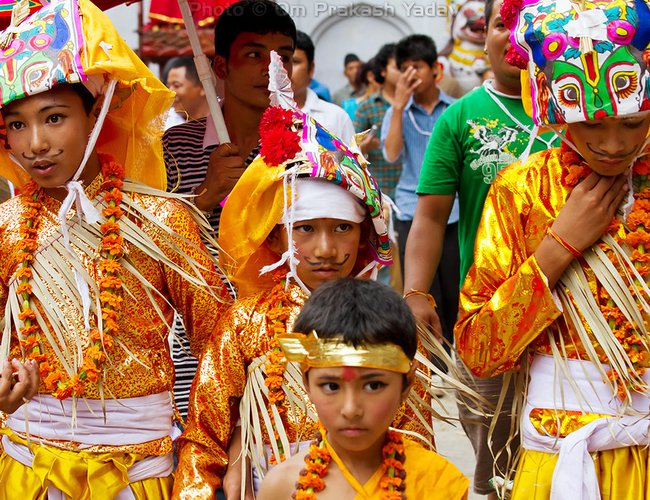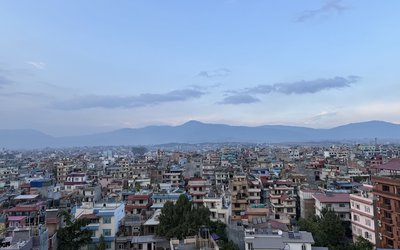
From early in the morning, people in Kathmandu valley are preparing for Gai Jatra Festival, a festival of dancing, singing, mirth and laughter. The festival of cow is celebrated in the Kathmandu Valley and Newar settlement in all over Nepal to commemorate the death of loved ones.
As part of the festival family members of the deceased of the past year send people mostly children. dressed as cows to parade on the streets.The festival usually falls in July or August.
Gai Jatra is a time to remember lost ones and also to ease the pain. The word "Gai" mans cow in English. Cow is regarded as the goddess of wealth in the Hindu religion. Sharing of sorrow and taking the comfort in knowing that their lost ones are safe is the true reason of celebrating this festival.
The day is also marked with a gay parade along with many people dressed is weird clothes. In Bhaktapur the festival lasts for eight days. The origin of this celebration goes back to the reign of the Malla rulers. It is said that the Malla Queen was in mourning for a long time after the untimely death of her son. The king in an attempt to console her asked every family that lost a loved one to come out in a procession to show the queen that she was not alone with her suffering. That is why there is much joy and joking during the procession that goes through the streets.
Going by just the name, you might think that Gai Jatra (or the festival of the cows) it’s something like the ‘running of the bulls’ festival in Pamplona. Well, that is really far from the mark. Gai Jatra, held on August16 this year.
It all started with the unfortunate death of a prince, during the Malla Era, when the most renowned of the Malla kings, King Pratap Malla (1641-1674), ruled over Kantipur (now Kathmandu). This king was responsible for building many monuments in Kantipur, including the statue of Hanuman at the royal palace gate, the tall column with statues of him and his family on top (famously known as Pratap Dhwaja) in the square, the Kal Bhairab Statue and the Krishna Temple (Chyasin Dega) in the same square, the white-colored Pratapur and Anantpur Temples in Swoyambhunath, and the Rani Pokhari (Queen’s Pond) near Ratna Park. (Unfortunately, Chyasin Dega was one among the many temples that were brought down to rubble by the tragic 7.8 magnitude earthquake of April 25, 2015.)
The story behind the making of Rani Pokhari is pretty interesting. It was built in memory of Chakrabartendra, the second eldest of Pratap Malla’s five sons, who had a most unfortunate death, being trampled by an elephant. The king filled the beautiful pond with water from all the holy rivers of the kingdom. This was to fulfill his queen’s wish of wanting to sanctify herself by bathing in the waters of all the sacred rivers of the kingdom.
Now, Rani Pokhari is an adjunct to the story of Gai Jatra, and both are closely intertwined, so let’s delve into it in some detail. The king had two wives and five sons from them: Bhupendra, Chakrabartendra, Nripendra, Mahipatendra, and Parthibendra. King Pratap Malla being an enlightened soul, he wanted to experiment with a new concept he had in mind. He wanted all of his five sons to have the experience of ruling a kingdom in his own lifetime, so he allotted one year of rule for each of his sons. As luck would have it, the second eldest son, Chakrabartendra, was trampled to death by an elephant on the second day of his taking over the reins.
His mother, the queen, was devastated, since he happened to be her favorite offspring. The sadness was such that she fell into a deep depression, and she spent the days wallowing in her misery. The king loved her, and he couldn’t bear to see her in such a state day after miserable day. He brought in all sorts of entertainment and entertainers to the court in repeated attempts to make her forget the tragedy. However, no matter how hard everybody tried, nobody could make her even smile a little, let alone laugh.
Finally, in desperation, the king asked his subjects to organize a parade in which one member of every family that had suffered a loss that year would take part. He ordered that they dress up in crazy and flashy costumes and drag a colorfully decorated cow along behind them. Those who didn’t have a cow could have someone dressed up as a cow. On this particular day, the king allowed his subjects to make jokes about existing social norms and people in powerful positions. Every sort of buffoonery and lampooning was permitted. This flamboyant parade was to pass along the main gates of the royal palace, from where the king and his queens would watch the revelry.
As the parade drew near, the king pointed out the huge contingent of participants, and told the grieving queen that every participant in the parade had suffered the death of a family member in the year gone by. On knowing this, the queen realized that she was, after all, not the only one who had been so aggrieved. Many others were grieving for the loss of a loved one, just as she was. However, that had not stopped them from moving on or taking part in a very funny kind of parade, dressed in weird clothes and cracking all sorts of jokes, laughing till their bellies hurt. Gradually, a smile of merriment began to form on her hereto grimly tight lips, and eventually a giggle escaped from her, which finally turned into laughter.
- Weather Forecast: Light To Moderate Rain In Few Places Of Hilly Areas Of Bagmati, Lumbini, Koshi And Gandaki Provinces
- May 21, 2025
- EU Delegation In Nepal Welcomes Delhi Based 21 Ambassadors From European Union
- May 20, 2025
- Nepali Business Delegation In Brazil
- May 20, 2025
- Weather Forecast: Light To Moderate Rain In Few Places Of Hilly Areas Of Koshi, Bagmati And Gandaki Provinces
- May 20, 2025
- EU Ambassadors Pay Courtesy Call on Foreign Minister
- May 19, 2025















